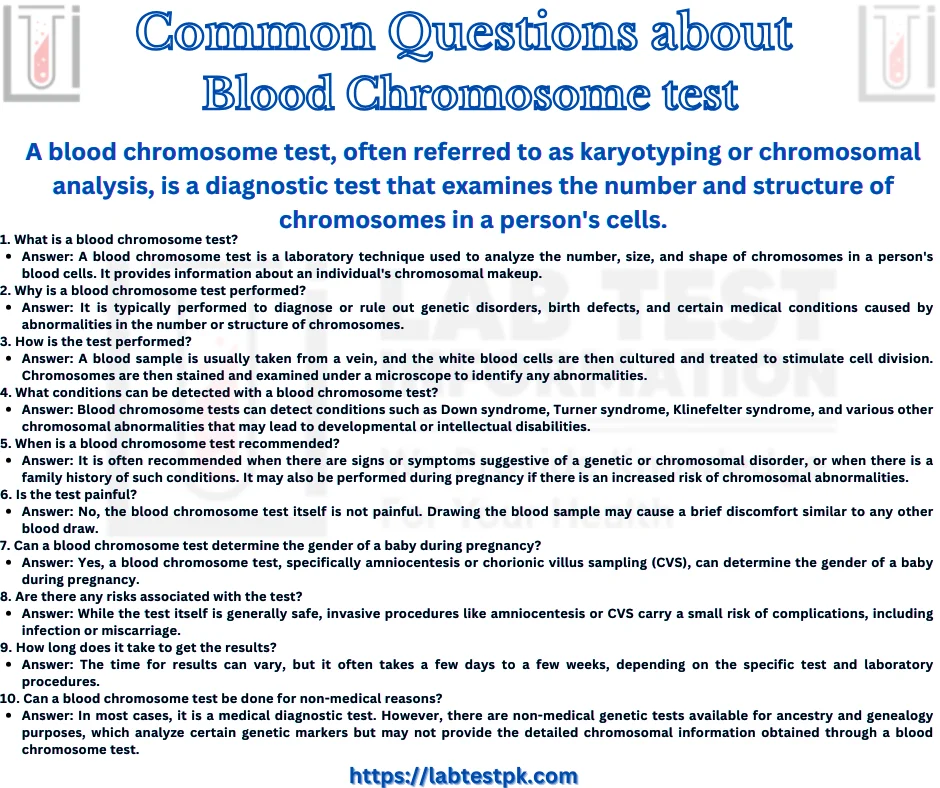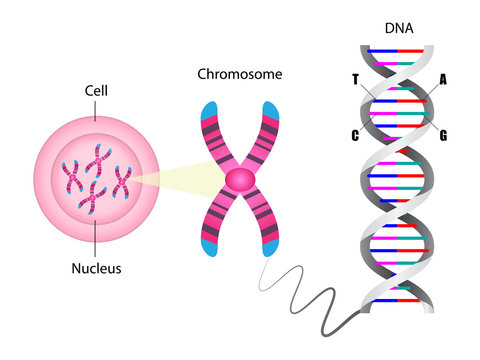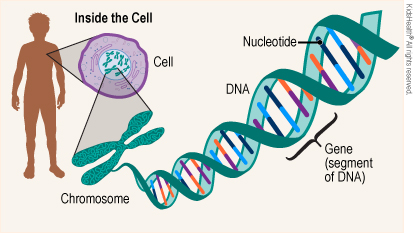Blood Chromosome, Blood cells, specifically white blood cells, can be used to examine chromosomes. The human body’s cells contain a nucleus and within the nucleus are structures called chromosomes. Chromosomes are thread-like structures made up of DNA and proteins, and they carry genes, which are the instructions for building and maintaining the body.
A human cell typically has 23 pairs of chromosomes, for a total of 46 chromosomes. These chromosomes carry the genetic information that determines various traits and characteristics.
The study of chromosomes, structure, and abnormalities is called cytogenetics. One common technique used to examine chromosomes is karyotyping. This involves arranging and photographing chromosomes from a cell in a way that makes it possible to see the number, size, and shape of chromosomes.
Blood samples are commonly used for cytogenetic testing because they contain white blood cells, which have a nucleus with chromosomes. This allows for the examination of an individual’s chromosomal makeup.
Cytogenetic testing can identify chromosomal abnormalities, such as aneuploidy (an abnormal number of chromosomes), translocations (rearrangements of chromosome segments), and other structural abnormalities. This type of testing is often performed in the diagnosis of genetic disorders, certain cancers, and fertility issues.
Chromosome Analysis Test:
Chromosome analysis, also known as karyotyping, is a laboratory test that examines the chromosomes in a sample of cells. This test can be performed on various types of cells, including blood cells, to analyze the number, size, and shape of chromosomes. Here’s a general overview of the chromosome analysis test:
1. Sample Collection:
- Blood Sample: A blood sample is usually collected from the patient. White blood cells containing the nucleus with chromosomes are then isolated for analysis.
- Other Tissues: In certain situations, other tissues, such as amniotic fluid, chorionic villus sampling (CVS), or bone marrow, may be used for chromosome analysis.
2. Cell Culture:
- The collected cells are cultured in a laboratory to stimulate cell division. This process is necessary to obtain enough cells for analysis.
3. Chromosome Harvesting:
- Once an adequate number of cells have been divided, the chromosomes are harvested from the cells.
4. Staining and Banding:
- The chromosomes are stained to enhance visibility, and specific banding techniques may be applied. These banding patterns help identify individual chromosomes and detect structural abnormalities.
5. Arrangement (Karyotyping):
- The chromosomes are arranged in pairs based on size, banding patterns, and other characteristics. This arrangement is called a karyotype.
6. Analysis and Interpretation:
- The karyotype is carefully analyzed by cytogeneticists. They look for numerical abnormalities (aneuploidy), structural abnormalities (such as translocations or deletions), and other irregularities.
7. Reporting:
- A detailed report is generated, summarizing the findings. This information can be crucial in diagnosing genetic disorders, identifying the cause of developmental delays, investigating fertility issues, or detecting certain types of cancer.
What This Test Can Tell:
Here are some key aspects that a chromosome analysis test can reveal:
-
Numerical Abnormalities (Aneuploidy):
- A common finding in chromosome analysis is the identification of numerical abnormalities, where there is an abnormal number of chromosomes. For example:
- Trisomy: An extra copy of a chromosome (e.g., Down syndrome is characterized by trisomy 21).
- Monosomy: Missing a copy of a chromosome.
- A common finding in chromosome analysis is the identification of numerical abnormalities, where there is an abnormal number of chromosomes. For example:
-
Structural Abnormalities:
- Chromosome analysis can detect structural changes in chromosomes, such as:
- Translocations: Rearrangements of chromosome segments between non-homologous chromosomes.
- Deletions: Loss of a portion of a chromosome.
- Duplications: Presence of additional copies of a chromosomal segment.
- Inversions: Reversal of the direction of a chromosomal segment.
- Chromosome analysis can detect structural changes in chromosomes, such as:
-
Genetic Disorders:
- Identification of specific chromosomal abnormalities is often associated with certain genetic disorders. For example:
- Down syndrome (Trisomy 21)
- Turner syndrome (Monosomy X)
- Klinefelter syndrome (XXY)
- Cri-du-chat syndrome (Deletion of part of chromosome 5)
- Identification of specific chromosomal abnormalities is often associated with certain genetic disorders. For example:
-
Cancer Diagnosis and Prognosis:
- Chromosome analysis is used in oncology to identify chromosomal abnormalities associated with cancer. Certain chromosomal changes are characteristic of specific types of cancer and can influence prognosis and treatment decisions.
-
Fertility Issues:
- Chromosome analysis can be employed in cases of infertility to identify chromosomal abnormalities that may contribute to reproductive challenges.
-
Prenatal Screening:
- During pregnancy, chromosome analysis is often used in prenatal screening to assess the risk of chromosomal abnormalities in the developing fetus. Common tests include amniocentesis and chorionic villus sampling (CVS).
-
Identification of Unknown Conditions:
- In cases where there are developmental delays, intellectual disabilities, or other unexplained health issues, chromosome analysis can help identify underlying genetic causes.
-
Research and Genetic Counseling:
- Chromosome analysis contributes to genetic research and is an essential tool in genetic counseling. It provides valuable information for families and healthcare providers to understand the genetic basis of certain conditions and make informed decisions.
It’s important to note that advancements in genetic testing, such as fluorescence in situ hybridization (FISH) and array comparative genomic hybridization (aCGH), provide more detailed information and can detect smaller chromosomal abnormalities that may not be visible with traditional karyotyping. The specific information obtained from a chromosome analysis depends on the clinical context and the reason for the testing. The interpretation of results is typically done by geneticists or cytogeneticists who specialize in analyzing chromosomal abnormalities.
What does the test result mean?
The interpretation of blood chromosome test results depends on the specific findings observed during the chromosome analysis (karyotyping). Here are some possible outcomes and what they may indicate:
-
Normal Result:
- If the chromosome analysis reveals a normal karyotype (46 chromosomes arranged in 23 pairs), it suggests that there are no major numerical or structural abnormalities in the analyzed cells.
-
Aneuploidy:
- If there is an abnormal number of chromosomes, it’s referred to as aneuploidy. For example:
- Trisomy: An extra copy of a chromosome (e.g., Trisomy 21 for Down syndrome).
- Monosomy: Missing a copy of a chromosome.
- The specific chromosome involved and the clinical context will determine the implications for health and development.
- If there is an abnormal number of chromosomes, it’s referred to as aneuploidy. For example:
-
Structural Abnormalities:
- If there are structural abnormalities, such as translocations, deletions, or duplications, the significance depends on the specific chromosomes involved and the size of the affected region. Some structural abnormalities may be associated with genetic disorders or an increased risk of certain health conditions.
-
Genetic Disorders:
- The presence of a specific chromosomal abnormality may indicate the presence of a known genetic disorder. For example, the identification of an extra chromosome 21 (Trisomy 21) is associated with Down syndrome.
-
Cancer-Related Changes:
- In cases where the chromosome analysis is performed for cancer diagnosis or prognosis, specific chromosomal changes may be indicative of certain types of cancer or provide information about the aggressiveness of the disease.
-
Fertility Issues:
- Chromosome analysis may identify abnormalities associated with fertility issues. For example, structural chromosomal rearrangements may affect reproductive health.
-
Prenatal Screening:
- In prenatal testing, the results can provide information about the risk of chromosomal abnormalities in the developing fetus. This information is important for parents to make informed decisions about the pregnancy.
-
Unknown Conditions:
- In some cases, the chromosome analysis may reveal abnormalities that are not associated with known genetic disorders. Further investigation may be needed to understand the clinical significance.
It’s crucial to note that the interpretation of chromosome analysis results requires expertise in cytogenetics. Genetic counselors and geneticists play a key role in providing detailed explanations of results to individuals and families, helping them understand the implications and potential next steps. The interpretation also takes into account the individual’s medical history, family history, and the reason for the testing. Additionally, advancements in genetic testing techniques, such as FISH and aCGH, provide more detailed information in certain cases.





[…] To detect the presence of human chorionic gonadotropin (hCG) hormone, an indicator of […]
[…] just one component of the diagnostic process. Additional tests, clinical evaluation, and sometimes genetic testing may be required for a comprehensive assessment. Interpretation of results should be done by a […]
[…] antibodies (ACAs) are a type of autoantibody that targets the centromere, a region of the chromosome involved in cell division. These antibodies are often associated with certain autoimmune diseases, […]
[…] is inserted through the abdomen into the amniotic sac under ultrasound guidance. A small amount of amniotic fluid, typically around 20 milliliters, is then withdrawn and sent to a laboratory for […]
[…] syndrome is a genetic disorder caused by the presence of an extra copy of chromosome 21, also known as trisomy 21. This condition leads to a range of developmental and physical […]
[…] a comprehensive explanation of the purpose, preparation, interpretation, and implications of blood tests and addresses a wide range of frequently asked questions regarding […]
[…] known as immature red blood cells. It is made up of the bone marrow and sent into the bloodstream. Red blood cells move oxygen from the lungs to every cell of the […]
[…] : Imbalances in estrogen levels can contribute to PCOS symptoms, including irregular periods and fertility issues. […]
[…] tool, not a diagnostic test. If the results indicate a high risk, further diagnostic tests, such as amniocentesis or chorionic villus sampling, may be recommended to confirm the […]
[…] osmolality test typically involves the collection of a blood or urine sample, and the procedure is relatively straightforward. Here’s what generally […]